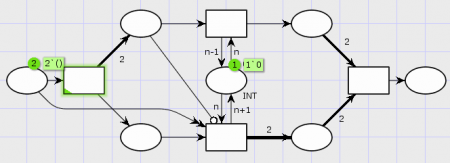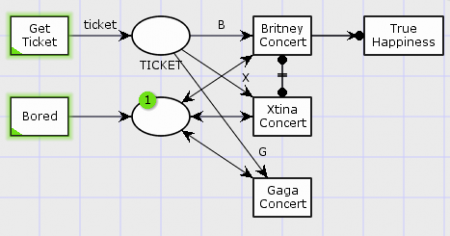CPN Tools 4 adds a couple new types to make modeling easier. The new types are intinf, real and time. These types makes it easier to construct readable models as we no longer have to represent large numbers using strings, we can use real values without any rounding, and we can directly embed time stamps […]
Category: Tutorials
CPN Tools 4: Place-Transition Petri Nets

CPN Tools is usually known for modeling with colored Petri nets. Colored Petri nets augment standard place-transition Petri nets (PT-nets) with data types, and as such are a real extension that can easily embed PT-nets. PT-nets come with a couple extensions that are crucial for this lower-level formalism, but which can be emulated in colored […]
CPN Tools 4: Declare Constraints

CPN Tools 4 merges the colored Petri net language with the Declare language. Declare was previously supported in its own tool, also named Declare. Everything herein can be done with CPN Tools pre-releases starting from 3.9.2; get your copy here. In colored Petri nets, the control flow is either dependent on data or on explicit […]
ProM 6 Plug-in Development; Part 4: Connections
In part 1 of this tutorial, we wen over the basics of ProM plug-in development and in parts 2 and 3 we extended our plug-in to better interact with ProM and the user. In this installment, we’ll look at how to make your plug-in work better with other plug-ins by providing extra information that may […]
Read More… from ProM 6 Plug-in Development; Part 4: Connections
ProM 6 Plug-in Development; Part 3: Provided Objects, Wizards, and More on Objects
In Part 1 of this tutorial we went over the basics, and in Part 2 we made our plug-in integrate better with ProM by making it possible to load and save objects, by providing a user-interface for configuration, and by providing progress and logging information when executing a plug-in. In this part, we look at […]
Read More… from ProM 6 Plug-in Development; Part 3: Provided Objects, Wizards, and More on Objects
ProM 6 Plug-in Development; Part 2: Loading/Saving, Configuration, and Feedback
In Part 1 of my tutorial on ProM plug-in development, we went over the basics: objects, plug-ins, and visualizers. In this part, we look into loading and saving objects, how to let users specify configuration, and how to make our plug-ins provide more information during execution. In the remainder of this post, I assume you […]
Read More… from ProM 6 Plug-in Development; Part 2: Loading/Saving, Configuration, and Feedback